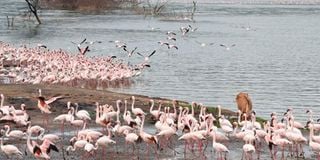Premium
Report offers insights into what caused rise of Rift Valley lakes

Flamingos at Lake Bogoria National Reserve in Baringo County, one of the tourists attraction sites in the county on July 19, 2021
Climate change, human activities and movement of tectonic plates are the reasons for the rise of Rift Valley lakes, a new report says.
According to the report titled “Rising water levels in Kenya’s rift valley lakes, Turkwel Gorge Dam and Lake Victoria”, different explanations have been advanced to explain these rising water levels, key among them being the transfer of water and energy between the land surface and the lower atmosphere (hydro-meteorology). Due to climate change, this has led to increased moisture availability, causing a rise in rainfall and discharge of the rivers feeding the lakes.
There is also more soil in runoff, occasioned by land-use changes that have increasingly added to the siltation of the lakes.
Dr Thecla Mutia, an environmental scientist at the Geothermal Development Company explained that climate change has led to increased moisture availability as seen in the discharge of rivers feeding the lakes and run-off occasioned by land-use changes, leading to high sediment load in the rivers, shoreline flooding, erosion, and geological changes.
A section of Lake Naivasha, where the government plans to construct a Sh520 million waterfront. The rising Waters of the lake have derailed the project that was set to begin in June. Treasury last year allocated Sh 300million for the project.
“We have also seen severe degradation of land due to human activity that has resulted in higher rainfall run-off from land and less percolation in groundwater systems, leading to a larger volume of water flowing directly and rapidly from the land surface into the lakes,” said Dr Mutia at a virtual conference on rising levels of the Rift Valley lakes in Eastern Africa. The multi-agency team behind the report were of a similar opinion, noting that changes in land-use practices had led to increased runoff.
Fault terrain
At the same time, all the Rift Valley lakes are situated in fault terrain in the geologically active Eastern Africa Rift Valley and are therefore controlled by the geological structures.
The increasing water levels are changing the composition of lake water thus affecting biodiversity. This is manifested in the reduced number of flamingoes as the growth of the algae they feed on has been affected by the change in the alkalinity of lake waters.
“The increased inflow of freshwater into some of these lakes has created instability in the already fragile ecology of the lakes, negatively affecting the resilience and distribution of certain water species. In some catchment areas, severe landslides occurred regularly,” point out the researchers.
The team cited Lake Naivasha on this front, with the affected areas including Kihoto Settlement and Kamere beach, where over 1,500 households were displaced, and a number of hotel facilities, properties, and power transformers submerged, posing a hazard to the community.

A section of Baruti-Mwariki village is submerged in water from the rising Lake Nakuru on May 31, 2020.
In the report, six people died in Kihoto because of distress and depression after their properties were destroyed. The fishing fraternity lost livelihoods due to beaches getting submerged. And although fish traders on Kamere public beach experienced increased fish yields, they suffered losses as catches went bad before reaching the market.
“The only available methods for preserving the fish are sun drying and deep-frying. Furthermore, the rising water levels had reduced business for the prime tourist hotels, thus leading to job losses,” the report notes.
Nile catchment
The findings mirror those documented in the 2020 UN state of the climate report launched last week showing that compared to totals between 1951 and 2010, precipitation levels rose (within the upper 10 per cent of values) in the northern Sahel region, Rift Valley, central Nile catchment and north-eastern Africa, Kalahari basin and lower course of the Congo River.
Southern parts of Kenya and Lake Victoria recorded the highest rainfall in 30 years, resulting in rising water levels in lakes in the Rift Valley as well as Lake Victoria.
The report was launched last week ahead of the UN climate Change Conference (COP26) from October 31 to November 12 in Glasgow, Scotland.

The roof of a house at Lake Nakuru National Park main gate that was submerged by rising Lake Nakuru waters.
“Within the last 50 years, we have seen 123 per cent increase in the water levels of Lake Solai, for instance,” said Prof Gilbert Obwoyere, an associate professor of landscape ecology and ecosystem health at Egerton University.
The researchers also found that the rising lake water levels have displaced people and wildlife from their homes, leading to increased cases of human-wildlife conflict.




